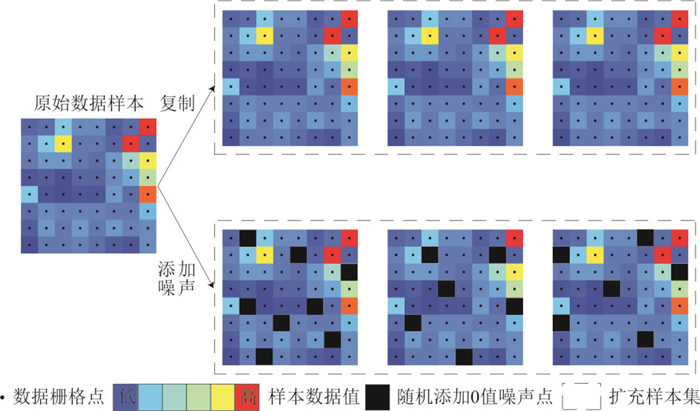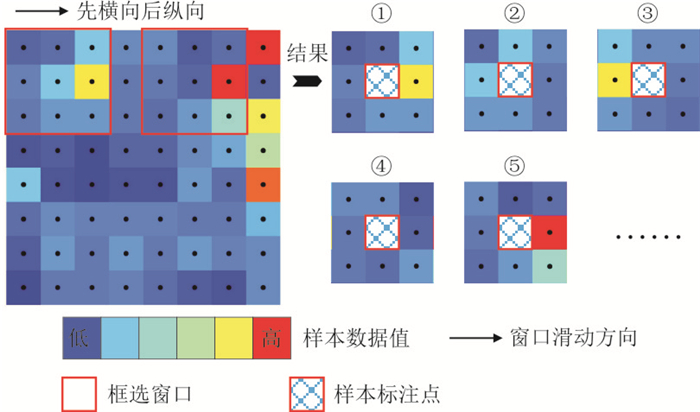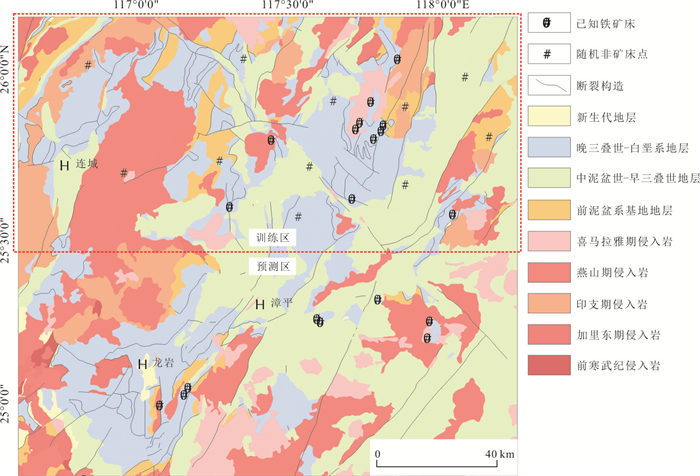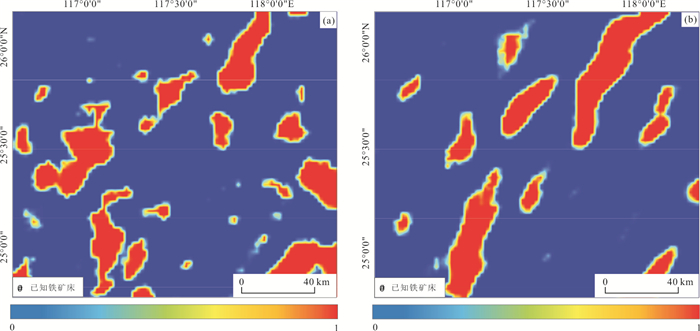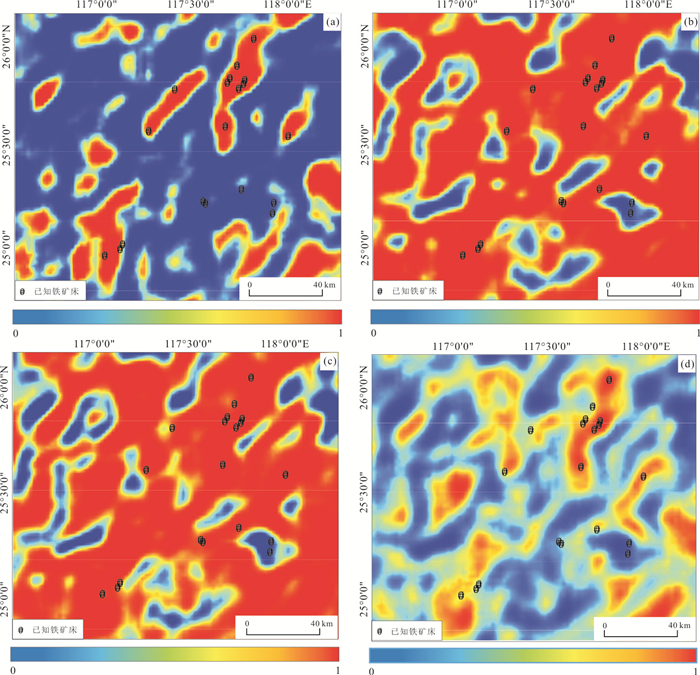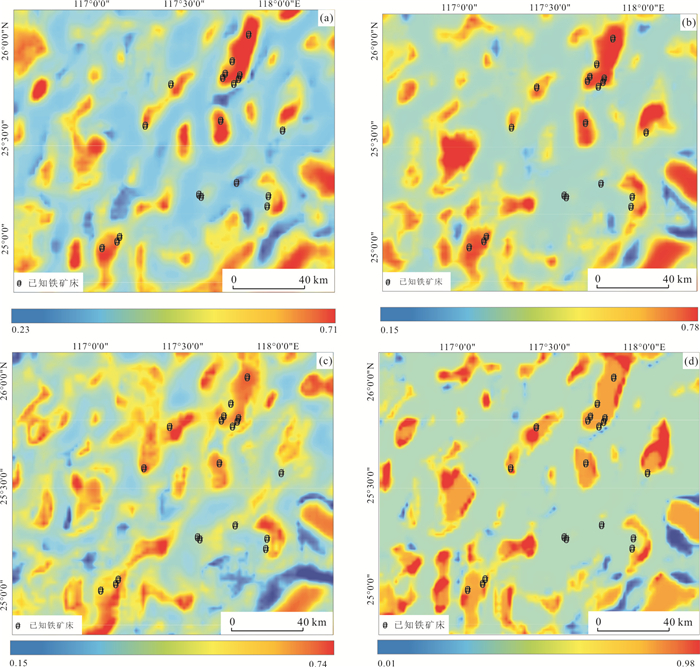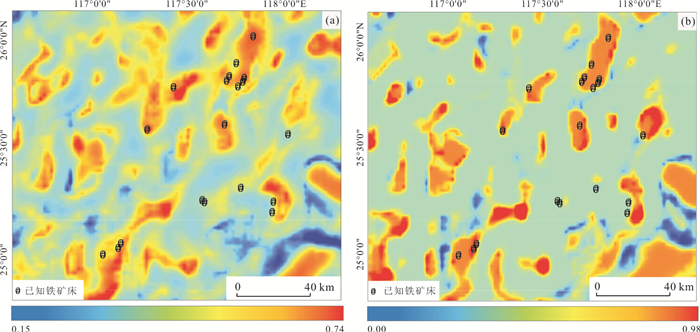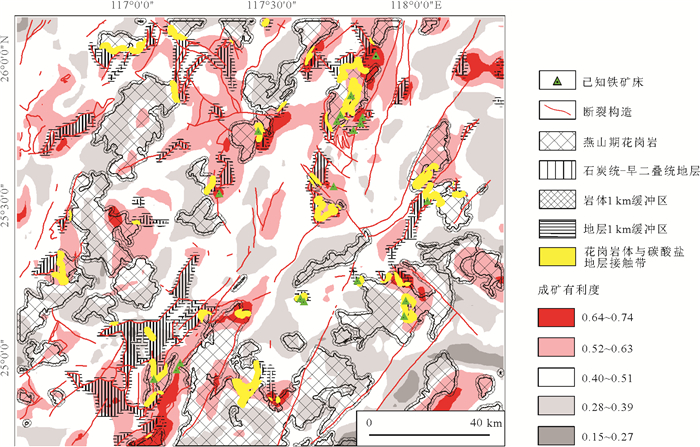Challenges of Geological Prospecting Big Data Mining and Integration Using Deep Learning Algorithms
-
摘要: 基于深度学习的地质找矿信息挖掘与集成已经成为数学地球科学的前沿领域.深度学习作为一种具有多级非线性变换的层级机器学习算法,在地质找矿大数据挖掘与集成中仍处于探索阶段,还有一系列问题亟需解决.以卷积神经网络为例,探讨了基于深度学习的地质找矿大数据挖掘与集成过程中两大挑战:训练样本不足和深度学习网络模型构建困难,重点分析了基于复制和添加噪声的地质找矿数据增强技术并开展了多组对比实验,构建了适用于地质找矿大数据挖掘与集成的训练样本和卷积神经网络模型.该模型对闽西南铁多金属成矿区的地质、地球物理和地球化学等多源数据进行了特征提取与集成融合,圈定了找矿远景区,为该区进一步找矿提供了科学依据.Abstract: Mining and integrating geological prospecting information using deep learning algorithms (DL) has become a frontier field of mathematical geoscience. DL,which is a machine learning algorithm with multiple hidden layers,starts to be used in mining the geological prospecting big data in recent years,and there are a series of issues to be solved in this field. In this study,we took the convolutional neural network (CNN) as an example to discuss two challenges of DL on mining geological prospecting big data,which include insufficient training samples and how to construct deep learning network structure. In this study,the data augmentation methods were applied to generate training dataset,duplicating and adding noise,and a number of number of experiments were carried out for determining the optimal hyper-parameters of a CNN model for mining and integrating geological prospecting big data. A case study from Southwest Fujian Province,China,was carried out to mine and integrate the geological,geophysical and geochemical multi-source prospecting information. The results obtained by CNN can provide clues for mineral exploration in this area.
-
图 4 研究区地质简图
Fig. 4. Simplified geological map of the study area Xiong et al.(2018)
-
Bengio, Y., Lamblin, P., Popovici, D., et al., 2007. Greedy Layer-Wise Training of Deep Networks. In Advances in Neural Information Processing Systems, London, 153-160. Chen, J. P., Li, J., Xie, S., et al., 2017. Geological Big Data Research in China. Journal of Geology, 41(3):353-366 (in Chinese with English abstract). Chen, J., Mao, X. C., Liu, Z.K., et al., 2020.Three-Dimensional Metallogenic Prediction Based on Random Forest Classification Algorithm for the Dayingezhuang Gold Deposit. Geotectonica et Metallogenia, 44(2):231-241 (in Chinese with English abstract). Chen, Y. L., Lu, L. J., Li, X. B., 2014. Application of Continuous Restricted Boltzmann Machine to Identify Multivariate Geochemical Anomaly. Journal of Geochemical Exploration, 140:56-63. https://doi.org/10.1016/j.gexplo.2014.02.013 Chen, Y. L., Wu, W., Zhao, Q. Y., 2020. A Bat Algorithm-Based Data-Driven Model for Mineral Prospectivity Mapping. Natural Resources Research, 29(1):247-265. https://doi.org/10.1007/s11053-019-09589-z Chen, Y. Q., Zhao, P. D., 2009. Extraction and Integration of Geo-Anomalies Associated with Mineralization. Earth Science, 34(2):325-335(in Chinese with English abstract). Cheng, Q. M., 2012. Singularity Theory and Methods for Mapping Geochemical Anomalies Caused by Buried Sources and for Predicting Undiscovered Mineral Deposits in Covered Areas. Journal of Geochemical Exploration, 122:55-70. https://doi.org/10.1016/j.gexplo.2012.07.007 Goodfellow, I., Pouget-Abadie, J., Mirza, M., et al., 2014. Generative Adversarial Nets. In Advances in Neural Information Processing Systems, London, 2672-2680. Graves, A., Mohamed, A. R., Hinton, G. E., 2013. Speech Recognition with Deep Recurrent Neural Networks. IEEE International Conference on Acoustics, Speech and Signal Processing, London, 6645-6649. http://doi.org/10.1109/ICASSP.2013.6638947 He, K., Zhang, X., Ren, S., et al., 2016. Deep Residual Learning for Image Recognition. IEEE Conference on Computer Vision and Pattern Recognition, London, 770-778. https://doi.org/10.1109/CVPR.2016.90 Hinton, G. E., Osindero, S., Teh, Y. W., 2006. A Fast Learning Algorithm for Deep Belief Nets. Neural Computation, 18(7):1527-1554. https://doi.org/10.1162/neco.2006.18.7.1527 Krizhevsky, A., Sutskever, I., Hinton, G. E., 2012. ImageNet Classification with Deep Convolutional Neural Networks. Proceedings of the Advances in Neural Information Processing Systems, London, 1097-1105. https://doi.org/10.1145/3065386 LeCun, Y., Bottou, L., Bengio, Y., et al., 1998. Gradient-Based Learning Applied to Document Recognition. Proceedings of the IEEE, 86(11):2278-2324. https://doi.org/10.1109/5.726791 LeCun, Y., Huang, F. J., Bottou, L., 2004. Learning Methods for Generic Object Recognition with Invariance to Pose and Lighting. Proceedings of the 2004 IEEE Computer Society Conference on Computer Vision and Pattern Recognition, 2: II-104. https://doi.org/10.1109/CVPR.2004.1315150 Li, S., Chen, J. P., Xiang, J., 2020. Applications of Deep Convolutional Neural Networks in Prospecting Prediction Based on Two-Dimensional Geological Big Data. Neural Computing and Applications, 32(7):2037-2053. https://doi.org/10.1007/s00521-019-04341-3 Liu, X.Y., Zhou, Y. Z., 2019. Application of Association Rule Algorithm in Studying Abnormal Elemental Associations in Panxijing Area in Western Guangdong Province, China. Earth Science Frontiers, 26(4):125-130 (in Chinese with English abstract). http://en.cnki.com.cn/Article_en/CJFDTotal-DXQY201904017.htm Liu, Y. P., Zhu, L. X., Zhou, Y. Z., 2018. Application of Convolutional Neural Network in Prospecting Prediction of Ore Deposits:Taking the Zhaojikou Pb-Zn Ore Deposit in Anhui Province as a Case. Acta Petrologica Sinica, 34(11):3217-3224 (in Chinese with English abstract). http://www.zhangqiaokeyan.com/academic-journal-cn_acta-petrologica-sinica_thesis/0201270234059.html Mignan, A., Broccardo, M., 2019. One Neuron Versus Deep Learning in Aftershock Prediction. Nature, 574(7776):E1-E3. https://doi.org/10.1038/s41586-019-1582-8 Mishkin, D., Sergievskiy, N., Matas, J., 2017. Systematic Evaluation of Convolution Neural Network Advances on the Imagenet. Computer Vision and Image Understanding, 161:11-19. https://doi.org/10.1016/j.cviu.2017.05.007 Szegedy, C., Liu, W., Jia, Y., et al., 2014. Going Deeper with Convolutions. In Proceedings of the IEEE Conference on Computer Vision and Pattern Recognition, London, 1-9. https://doi.org/10.1109/CVPR.2015.7298594 Vasconcelos, C. N., Vasconcelos, B. N., 2017. Convolutional neural network committees for melanoma classification with classical and expert knowledge based image transforms data augmentation. arXiv preprint arXiv: 1702.07025 Wang, J., Perez, L., 2017. The Effectiveness of Data Augmentation in Image Classification Using Deep Learning. Convolutional Neural Networks Vis. Recignit: 1712.04621 Weyn, J. A., Durran, D. R., Caruana, R., 2019. Can Machines Learn to Predict Weather? Using Deep Learning to Predict Gridded 500 hPa Geopotential Height from Historical Weather Data. Journal of Advances in Modeling Earth Systems, 11(8):2680-2693. https://doi.org/10.1029/2019ms001705 Wu, C.L., Liu, G., Zhang, X, L., et al., 2016. Discussion on Geological Science Big Data and Its Applications. Chinese Science Bulletin, 61(16):1797-1807 (in Chinese with English abstract). doi: 10.1360/N972015-01035 Xiao, K. Y., Sun, L., Li, N., et al., 2015. Mineral Resources Assessment under the Thought of Big Data. Geological Bulletin of China, 4(7):1266-1272 (in Chinese with English abstract). http://www.researchgate.net/publication/283105011_Mineral_resources_assessment_under_the_thought_of_big_data Xiong, Y. H., Zuo, R. G., Carranza, E. J. M., 2018. Mapping Mineral Prospectivity through Big Data Analytics and a Deep Learning Algorithm. Ore Geology Reviews, 102:811-817. https://doi.org/10.1016/j.oregeorev.2018.10.006 Zhang, X. L., Wu, C. L, Zhou, Q., et al., 2020. Multi-Scale 3D Modeling and Visualization of Super Large Manganese Ore Gathering Area in Guizhou China. Earth Science, 2020, 45(2):634-644 (in Chinese with English abstract). Zhang, S., Xiao, K. Y., Carranza, E. J. M., et al., 2019. Integration of Auto-Encoder Network with Density-Based Spatial Clustering for Geochemical Anomaly Detection for Mineral Exploration. Computers & Geosciences, 130:43-56. https://doi.org/10.1016/j.cageo.2019.05.011 Zhao, P. D., 2019. Characteristics and Rational Utilization of Geological Big Data. Earth Science Frontiers, 26(4):1-5(in Chinese with English abstract). http://en.cnki.com.cn/Article_en/CJFDTotal-DXQY201904002.htm Zhou, Y. Z., Chen, S., Zhang, Q., et al., 2018. Advances and Prospects of Big Data and Mathematical Geoscience. Acta Petrologica Sinica, 34(2):255-63 (in Chinese with English abstract). http://en.cnki.com.cn/Article_en/CJFDTotal-YSXB201802001.htm Zuo, R. G., Xiong, Y. H., Wang, J., et al., 2019. Deep Learning and its Application in Geochemical Mapping. Earth-ScienceReviews, 192:1-14. https://doi.org/10.1016/j.earscirev.2019.02.023 陈进, 毛先成, 刘占坤, 等, 2020.基于随机森林算法的大尹格庄金矿床三维成矿预测.大地构造与成矿学, 44(2):231-241. https://www.cnki.com.cn/Article/CJFDTOTAL-DGYK202002008.htm 陈建平, 李靖, 谢帅, 等, 2017.中国地质大数据研究现状.地质学刊, 41(3):353-366. https://www.cnki.com.cn/Article/CJFDTOTAL-JSDZ201703001.htm 陈永清, 赵鹏大, 2009.综合致矿地质异常信息提取与集成.地球科学-中国地质大学学报, 34(2):325-335. doi: 10.3321/j.issn:1000-2383.2009.02.016 刘心怡, 周永章, 2019.关联规则算法在粤西庞西垌地区元素异常组合研究中的应用.地学前缘, 26(4):125-130. https://www.cnki.com.cn/Article/CJFDTOTAL-DXQY201904017.htm 刘艳鹏, 朱立新, 周永章, 2018.卷积神经网络及其在矿床找矿预测中的应用-以安徽省兆吉口铅锌矿床为例.岩石学报, 34(11):3217-3224. https://www.cnki.com.cn/Article/CJFDTOTAL-YSXB201811007.htm 吴冲龙, 刘刚, 张夏林, 等, 2016.地质科学大数据及其利用的若干问题探讨.科学通报, 61(16):1797-1807. https://www.cnki.com.cn/Article/CJFDTOTAL-KXTB201616011.htm 肖克炎, 孙莉, 李楠, 等, 2015.大数据思维下的矿产资源评价.地质通报, 34(7):1266-1272. doi: 10.3969/j.issn.1671-2552.2015.07.003 张夏林, 吴冲龙, 周琦, 等, 2020.贵州超大型锰矿集区的多尺度三维地质建模.地球科学, 45(2):634-644. doi: 10.3799/dqkx.2018.384 赵鹏大, 2019.地质大数据特点及其合理开发利用.地学前缘, 26(4):1-5. https://www.cnki.com.cn/Article/CJFDTOTAL-DXQY201904002.htm 周永章, 陈烁, 张旗, 等, 2018.大数据与数学地球科学研究进展-大数据与数学地球科学专题代序.岩石学报, 34(2):255-263. https://www.cnki.com.cn/Article/CJFDTOTAL-YSXB201802001.htm -










 下载:
下载:
